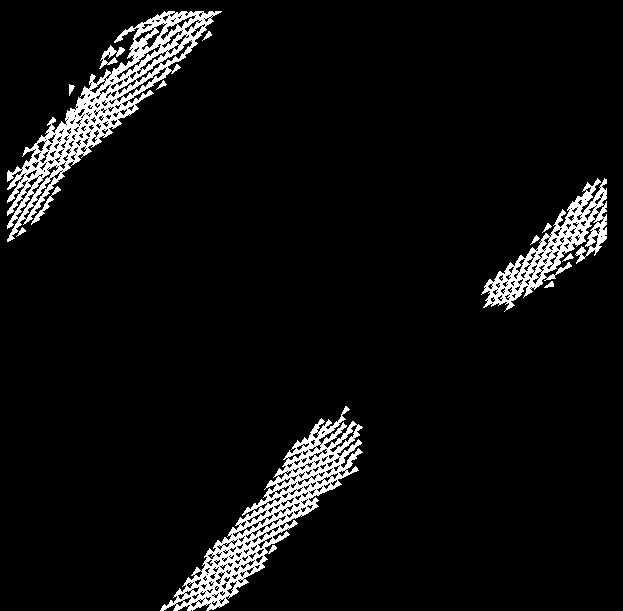WebGPU学习(十):介绍“GPU实现粒子效果”
大家好,本文介绍了“GPU实现粒子效果”的基本思想,并推荐了相应的学习资料。
本文学习webgpu-samplers->computeBoids示例,它展示了如何用compute shader实现粒子效果,模拟鸟群的行为。
上一篇博文:
WebGPU学习(九):学习“fractalCube”示例
下一篇博文:
WebGPU学习(十一):学习两个优化:“reuse render command buffer”和“dynamic uniform buffer offset”
最终渲染结果:

为什么不在CPU端实现粒子效果?
虽然在CPU端实现会更灵活和可控,但如果粒子数量很大(如上百万),且与场景有交互,则最好在GPU端实现。
示例的实现思想
首先执行compute pass
代码如下:
const numParticles = 1500;
...
let t = 0;
return function frame() {
...
const commandEncoder = device.createCommandEncoder({});
{
const passEncoder = commandEncoder.beginComputePass();
passEncoder.setPipeline(computePipeline);
passEncoder.setBindGroup(0, particleBindGroups[t % 2]);
passEncoder.dispatch(numParticles);
passEncoder.endPass();
}
...
++t;
}
我们对这个pass进行分析:
particleBindGroups包含两个storage buffer:ParticlesA和ParticlesB
ParticlesA存储了上一帧所有粒子的数据。compute shader首先读取它,然后计算出下一帧所有粒子的数据,最好写到ParticlesB中。这样就打了一个ping-pong操作;
注:storage buffer在shader中可被读或写,而uniform buffer、vertex buffer等在shader中只能被读
dispatch到1500个instance,每个instance执行一次compute shader
compute shader计算每个粒子的数据时,需要遍历其它的所有粒子,计算相互的交互作用。
一共有1500个粒子,共需要计算15001500次。
如果在CPU端执行,只能串行计算,一共需要计算15001500次;
如果在GPU端执行,GPU有1500个instance,每个instance并行地计算1500次,因此一共只需要计算1500次,大大提高了效率。
然后执行render pass
代码如下:
const numParticles = 1500;
...
const renderPipeline = device.createRenderPipeline({
...
vertexState: {
vertexBuffers: [{
// instanced particles buffer
arrayStride: 4 * 4,
stepMode: "instance",
attributes: [{
// instance position
shaderLocation: 0,
offset: 0,
format: "float2"
}, {
// instance velocity
shaderLocation: 1,
offset: 2 * 4,
format: "float2"
}],
}, {
// vertex buffer
arrayStride: 2 * 4,
stepMode: "vertex",
attributes: [{
// vertex positions
shaderLocation: 2,
offset: 0,
format: "float2"
}],
}],
},
...
});
...
const vertexBufferData = new Float32Array([-0.01, -0.02, 0.01, -0.02, 0.00, 0.02]);
const verticesBuffer = device.createBuffer({
size: vertexBufferData.byteLength,
usage: GPUBufferUsage.VERTEX | GPUBufferUsage.COPY_DST,
});
verticesBuffer.setSubData(0, vertexBufferData);
...
return function frame() {
...
const commandEncoder = device.createCommandEncoder({});
...
{
const passEncoder = commandEncoder.beginRenderPass(renderPassDescriptor);
passEncoder.setPipeline(renderPipeline);
//ParticlesB使用“instance”的stepMode,被设置到第一个vertex buffer中
passEncoder.setVertexBuffer(0, particleBuffers[(t + 1) % 2]);
//vertices buffer(包含3个顶点数据,每个顶点数据包含x坐标和y坐标)使用“vertex”的stepMode,被设置到第二个vertex buffer中
passEncoder.setVertexBuffer(1, verticesBuffer);
//draw一次,绘制1500个实例(使用ParticlesB的数据),其中每个实例有3个顶点(使用vertices buffer的数据)
//注:每个粒子作为一个实例,由包含3个顶点的三角形组成
passEncoder.draw(3, numParticles, 0, 0);
passEncoder.endPass();
}
...
}
推荐学习资料
大家可以参考WebGPU-8,来学习示例的具体的代码。
虽然该文对应的示例代码的版本比较老(如它的示例中是1000个粒子,而不是1500个粒子),但与本文对应的最新版本基本上相同,而且它对示例代码分析得比较详细,所以推荐大家学习。
另外,大家可以通过Get started with GPU Compute on the Web,学习如何使用compute shader计算矩阵运算。





【推荐】国内首个AI IDE,深度理解中文开发场景,立即下载体验Trae
【推荐】编程新体验,更懂你的AI,立即体验豆包MarsCode编程助手
【推荐】抖音旗下AI助手豆包,你的智能百科全书,全免费不限次数
【推荐】轻量又高性能的 SSH 工具 IShell:AI 加持,快人一步
· go语言实现终端里的倒计时
· 如何编写易于单元测试的代码
· 10年+ .NET Coder 心语,封装的思维:从隐藏、稳定开始理解其本质意义
· .NET Core 中如何实现缓存的预热?
· 从 HTTP 原因短语缺失研究 HTTP/2 和 HTTP/3 的设计差异
· 周边上新:园子的第一款马克杯温暖上架
· Open-Sora 2.0 重磅开源!
· 分享 3 个 .NET 开源的文件压缩处理库,助力快速实现文件压缩解压功能!
· Ollama——大语言模型本地部署的极速利器
· DeepSeek如何颠覆传统软件测试?测试工程师会被淘汰吗?